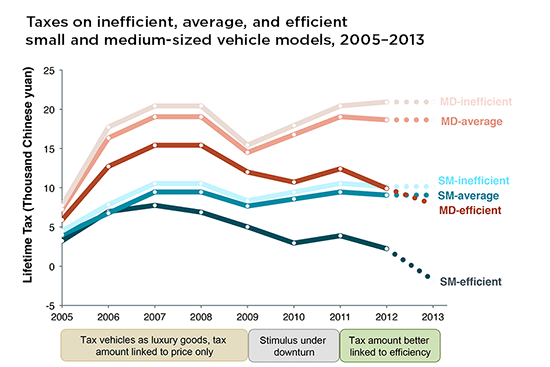Blog
China shifting to performance-based incentives for vehicle efficiency
Vehicle sales in China more than tripled between 2007 and 2011, and that rate of growth is not expected to slow anytime soon. As a complement to the supply-side approach of enacting increasingly stringent vehicle efficiency standards aimed at improving fuel economy and reducing GHG emissions, a pragmatic and effective solution on the demand side is to provide consumers with purchase incentives linked directly to vehicle efficiency or GHG emissions.
China’s energy-efficient and new energy vehicle policy of 2010 moved in that direction by rewarding certain technologies, including plug-in hybrids and battery electric vehicles. Recently Mr. Miao Wei, China’s Minister of Industry and Information Technology, announced the government’s intention to revise that policy and make fuel efficiency, not technology, the primary criteria to determine the magnitude of the incentives. This important change indicates that China is gradually shifting to performance-based incentive policies for vehicle efficiency.
The table below (click to enlarge) illustrates this shift. It shows a snapshot of the historical evolution of China’s taxation and other incentive policies for automobiles, focusing on their relative proximity to a true incentive for efficiency (CO2 emissions). As shown, vehicle efficiency emerges as the primary criteria (or at least one of the criteria) that determine the magnitude of the incentives among some of the newest policies in the past few years.
Existing nation-wide taxes and incentives for automobiles in rough timeline. [See below for notes and sources.]
This chart (click to enlarge) shows the amount of tax (in absolute-dollar terms) for a set of inefficient, average, and efficient vehicle models in two broad vehicle segments: small cars (approximately 1L engine) and medium-sized cars (approximately 1.6L engine). The growing gaps between the amount of tax levied on efficient and inefficient cars over the period from 2005 to 2012 indicate that the overall impact of the policies provides greater incentive for vehicle fuel efficiency.
While the details of the upcoming revision of the new energy and efficient vehicle subsidy are not final, following the concept of what Mr. Miao introduced (linking incentives more closely to gains in fuel efficiency), we designed a hypothetical incentive scheme and applied it to the 2013 tax calculation: a subsidy of 600 CNY for every 1 percent of a vehicle model compared to its phase-3 fuel consumption standard for its weight bin (shown as the dotted part of the figure).
Under such a scheme, the incentive for vehicle efficiency is even stronger in 2013 than in 2012, and fairer to all technologies. A JAC-Yueyue with 915 kg curb weight is 12% lower than its phase-3 standard (5.8L/100km), and would be subsidized in the amount of 7,200 CNY, compared to 3,000 CNY under the previous policies.
This is an important change in policy that will have far-reaching effects in promoting vehicle efficiency regardless of the technology path, and one that we applaud at the ICCT. Even better, of course, would be pure performance-based policy directly linked to vehicle fuel consumption or CO2 emissions.
Notes and sources for the table
* The acquisition tax was temporarily lowered for vehicles with 1.6L or smaller engine size during the economic downturn from the beginning of 2008 to end of 2009.
+ While for the entire fleet, the vehicle and vessel taxes are based on engine size, starting in 2012 a special incentive for energy-efficient vehicles and new-energy vehicles was introduced, under which efficient vehicles are subject to half of the regular tax rates and NEVs are exempted from the tax.
The multiple bars in the same policy row indicate revisions/updates to that specific tax/policy item in different years.
Sources:
- Excise tax: Ministry of Finance, State Administration of Taxation, [2008]105, http://www.chinatax.gov.cn/n8136506/n8136593/n8137537/n8138502/8315602.html
- Acquisition tax: State Administration of Taxation, Executive Order No. 27, http://www.chinatax.gov.cn/n8136506/n8136593/n8137537/n8138502/11780014.html
- Vehicle and vessel tax: Ministry of Finance, State Administration of Taxation, Executive Order No. 47, 2007, http://www.gov.cn/gongbao/content/content_859877.htm
- Energy-saving product subsidy for energy-saving automobiles: Ministry of Finance, National Development and Reform Commission, [2010]219, http://www.sdpc.gov.cn/zcfb/zcfbqt/2010qt/t20100603_351138.htm
- New energy vehicle subsidy: Ministry of Finance, Ministry of Science and Technology, [2009]6, http://jjs.mof.gov.cn/zhengwuxinxi/zhengcefagui/200902/t20090205_111617.html, and [2010]230, http://www.sdpc.gov.cn/zcfb/zcfbqt/2010qt/t20100603_351147.htm


